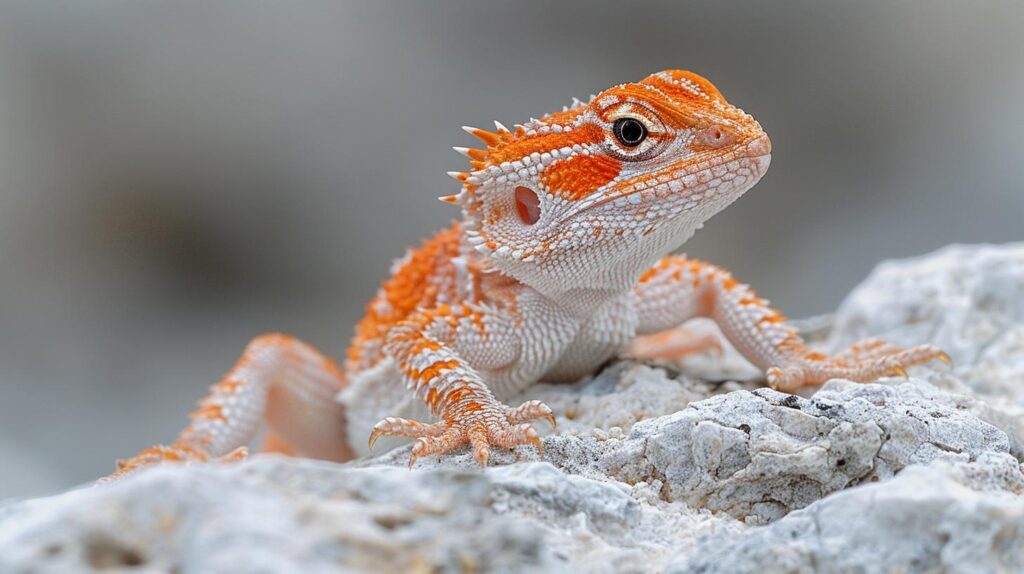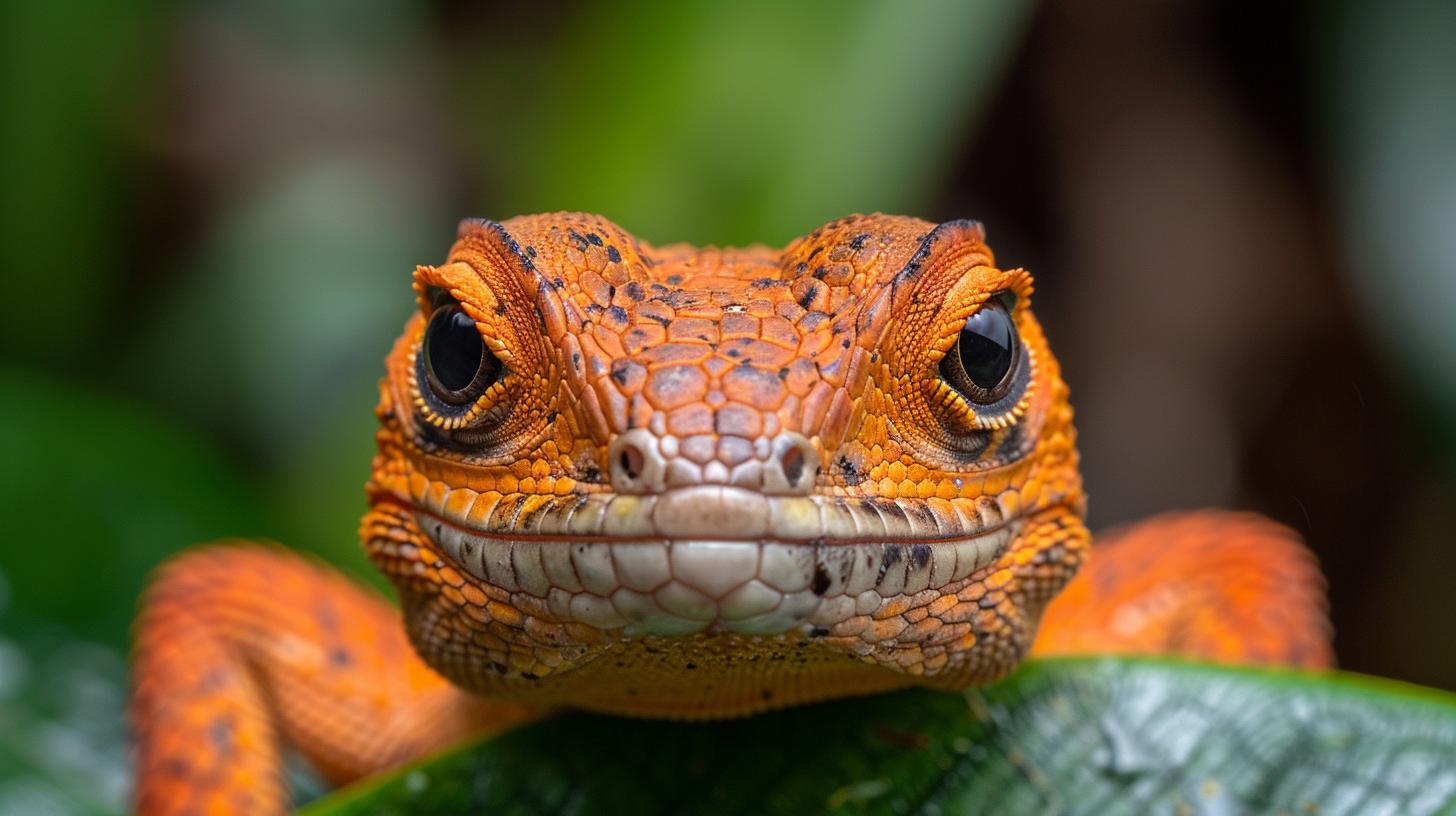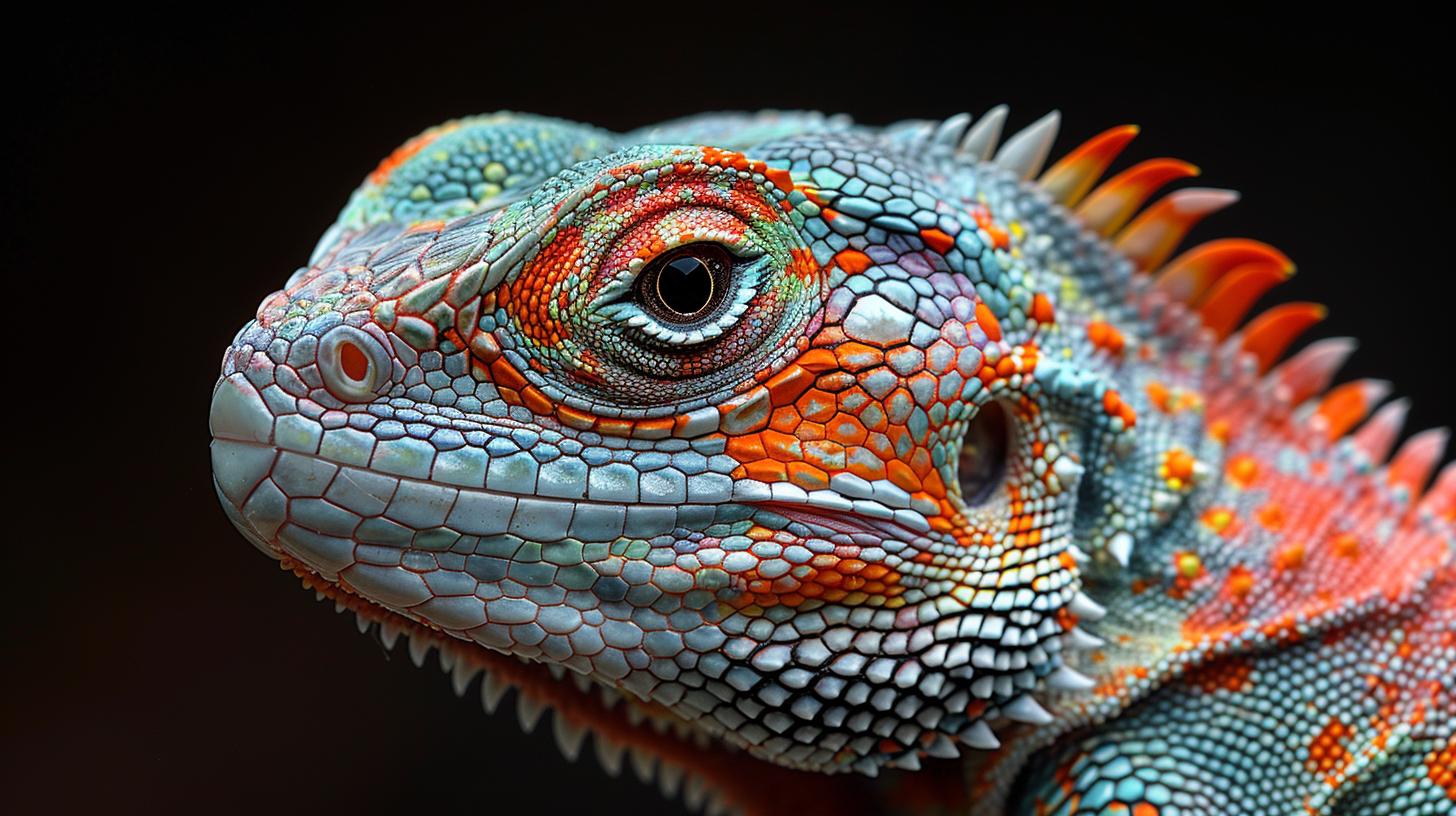Lizard Skin Infections: A Care and Treatment Guide

Understanding Lizard Skin Infections
When it comes to maintaining the health and vitality of our reptilian companions, understanding lizard skin care is essential. Skin infections in lizards can be a perplexing issue for many pet owners.
These infections are far from just cosmetic concerns; they can be indicators of deeper health issues, directly impacting a lizard's behavior, comfort, and overall well-being. By examining the common causes such as bacteria, fungi, and parasites, pet owners can gain insights into how these culprits invade and affect their pets.
Skin conditions in lizards are not only diverse but can also be subtle in their early stages. Identifying the signs and symptoms of these infections requires a keen eye. Changes in coloration, texture abnormalities, unusual shedding patterns, or the sudden appearance of sores or blisters signify that all is not right with your scaly friend's epidermis. Early detection plays a pivotal role in mitigating more serious complications that could arise if left unattended.
Among the myriad of skin afflictions that can beset lizards, bacterial, fungal, and parasitic infections stand out for their frequency and potential severity. Each type comes with its distinct set of challenges-bacterial infections often necessitate antibiotic treatments; fungal issues call for antifungal measures; meanwhile, parasitic invasions require targeted strategies to eliminate the unwelcome guests.
Understanding these distinctions is crucial for any reptile owner looking to ensure their pet's health and happiness. Through this segment dedicated to lizard skin infection, readers will explore not just the implications but also the steps needed to diagnose and effectively manage these conditions under professional guidance.
Identifying Signs and Symptoms
Recognizing the signs and symptoms of skin infections in lizards is essential for timely and effective treatment. Various factors can contribute to the development of skin issues, including improper humidity levels, unsanitary living conditions, or exposure to infected lizards. A keen eye on your pet's behavior and appearance can be the first line of defense against more serious health complications. Several indicators suggest that your lizard might be dealing with a skin infection.
Firstly, a noticeable change in the color or texture of the lizard's skin often signals trouble. This could manifest as unusual spots, discoloration, or rough patches that were not present before. Infected areas may appear redder or darker than the surrounding skin due to inflammation or bleeding beneath the surface. Additionally, an increase in shedding frequency or difficulties shedding (known as dysecdysis) can also point towards an underlying issue needing attention.
Secondly, the presence of sores, blisters, or scabs on a lizard's body indicates a severe infection that necessitates immediate care. These lesions are not only painful but also serve as gateways for further bacterial or fungal growth if left untreated. Observing any abnormal swelling or bloating in conjunction with these signs is critical; this could signify systemic infection spreading beyond just the skin.
Lastly, a general decline in well-being marked by lethargy, loss of appetite, or uncharacteristic aggressiveness suggests an animal struggling internally-possibly due to discomfort caused by a skin infection among other illnesses. It's important to consider behavioral changes alongside physical symptoms when evaluating your pet's health.
Incorporating *lizard skin care* into your regular pet maintenance routine is crucial for preventing such infections from taking hold. This involves:
- Regular habitat cleaning to remove waste and unwanted moisture.
- Monitoring and adjusting humidity levels appropriate for your species of lizard.
- Offering a balanced diet rich in nutrients necessary for strong immune function.
Understanding these signs and symptoms empowers reptile owners to act swiftly at the first indication of trouble. Early detection followed by immediate action-be it changes in care routines or seeking veterinary assistance-can make all the difference in managing lizard skin infections effectively without allowing them to escalate into more hazardous territory.
As we move forward into discussing common types of infections and their treatments, keep these key observations in mind as foundational knowledge for ensuring optimal care and swift recovery for our scaled companions.
Common Types of Lizard Skin Infections
Understanding the variety of skin infections that can afflict lizards is pivotal for any reptile owner. These conditions, caused by bacteria, fungi, or parasites, can significantly impact a lizard's health if not promptly addressed. Knowledge of these common types is the first step towards effective prevention and treatment.
This will not only enhance the quality of life for your pet but also mitigate against more serious complications developing. Each type of infection has distinct characteristics and symptoms, making it essential to identify them accurately for proper care.
Bacterial Infections
Bacterial infections are among the most prevalent skin issues faced by lizards. They often manifest as visible sores or lesions on the skin surface which may discharge pus or fluid. Improper living conditions, such as unclean habitats or incorrect humidity levels, are typical culprits that facilitate the growth of harmful bacteria.
These conditions compromise the integrity of a lizard's skin, making it more susceptible to infections. Immediate attention and treatment are crucial in preventing the spread and escalation of bacterial infections within your reptile's system.
Fungal Infections
Another significant concern is fungal infections, which present differently than their bacterial counterparts. Lizards suffering from fungal issues might display irregular shedding patterns or develop crusty patches on their skin. The nature of fungi to thrive in moist environments underscores the necessity for maintaining optimal humidity levels in your lizard's habitat. Fungal spores can easily colonize on damp surfaces or skin wounds, leading to widespread infection if left unchecked.

Parasitic Infestations
Parasites pose another threat to lizards, with mites and ticks being amongst the most common offenders. These tiny creatures feed on your lizard's blood, potentially transmitting diseases in the process or causing irritation and inflammation of the skin. It's imperative for lizard owners to regularly inspect their pets for signs of parasitic infestation such as redness or small bumps on the skin where these pests might be feeding or residing.
Tailored strategies encompassing meticulous hygiene practices and regular health checks form an integral part of lizard skin care By understanding these common types of lizard skin infections and recognizing their signs early on, you stand a much better chance at safeguarding your scaly friend against unnecessary discomfort and potential health hazards.
Preventative Measures for Lizard Skin Care
Understanding how to prevent lizard skin infections is crucial for any reptile owner. By focusing on preventative measures, one can greatly reduce the risk of these conditions, ensuring a healthier and happier pet. This section not only highlights the importance of maintaining optimal living conditions but also sheds light on the key aspects of lizard skin care that can fend off the onset of infections.
Environmental control plays a pivotal role in preventing skin issues. Lizards thrive in habitats that mimic their natural environments as closely as possible, with specific requirements for humidity and temperature that vary across species. Creating a home that meets these conditions is essential not only for their overall health but specifically for maintaining healthy skin.
Both excessive dryness and overly humid conditions can create breeding grounds for bacteria and fungi, leading to infections. Therefore, understanding and implementing precise environmental controls is a fundamental preventive measure.
Regular Habitat Cleaning
One cannot stress enough the importance of cleanliness in preventing lizard skin infections. Habitats should be cleaned regularly to prevent the buildup of harmful pathogens that can lead to skin infections This includes daily spot checks and complete habitat cleanings at regular intervals.
Removing uneaten food, waste products, and shedding skin promptly keeps the environment hygienic and reduces exposure risks. Moreover, disinfecting the habitat with reptile-safe cleaners eliminates lingering microbes without introducing harmful chemicals that could irritate your lizard's skin.
Optimal Diet and Hydration
A balanced diet plays an integral part in maintaining healthy lizard skin care Nutritional deficiencies can weaken a lizard's immune system, making them more susceptible to infections.
Providing a diet rich in essential vitamins and minerals supports not only their overall health but specifically fortifies their skin against potential invaders. Similarly, adequate hydration is vital; dehydrated lizards are at a higher risk for developing dry, cracked skin which can serve as entry points for infection-causing bacteria or fungi.
Through these preventative measures-meticulous environmental control, regular habitat cleaning, and ensuring a nutritious diet along with proper hydration-owners can vastly minimize the risk of their lizards developing skin infections. Incorporating these practices into daily care routines fosters an environment where lizards can thrive both physically and emotionally while standing guard against common health concerns such as bacterial or fungal skin diseases.
First Aid and Home Care Tips
The initial response to spotting signs of a skin infection in your lizard is critical. Before rushing to conclusions or starting any form of treatment, it's vital to accurately identify the symptoms your pet lizard is exhibiting.
Signs such as irregular shedding, discoloration, or the appearance of sores are indicators that something isn't right. While these symptoms can indeed point towards a need for lizard skin care, they also necessitate a balanced approach to avoid further distress to your pet.
When you first notice these signs, gentle cleaning of the affected area with lukewarm water can help maintain cleanliness and prevent aggravation of the infection. It's important here not to use any harsh chemicals or detergents, as lizards have sensitive skin that could react negatively to such substances. Keeping your lizard's habitat clean is equally crucial; ensure that its living space is sanitized but not with strong chemicals, opting instead for reptile-friendly cleaning agents.
- Maintain optimal humidity levels in the habitat according to the species-specific needs.
- Ensure the diet you're providing is rich and varied, catering to their nutritional requirements which play a significant role in maintaining healthy skin.
- Remove any potential contaminants from their environment which could introduce harmful bacteria or parasites.
It's essential, however, not to undertake any serious medical treatments at home without professional guidance. For instance, applying over-the-counter creams or ointments intended for humans can be harmful due to differences in our skins' absorbency and reactions to certain ingredients. *Lizard skin care* should be approached with caution and sensitivity towards these unique creatures' needs.
This stage paves the way for understanding when home care might not suffice. Home remedies serve as immediate steps one can take but do not replace professional veterinary advice or treatment plans. Introduction to proper *veterinary treatments* becomes imperative if home interventions show no sign of improvement. Acting promptly by consulting a reptile-savvy veterinarian gives your lizard the best chance at overcoming its skin ailment efficiently and safely.

Taking these preventive measures seriously forms an integral part of nurturing a healthy environment for your lizard which minimizes stress-a common contributor to lowered immunity which can make them more susceptible to infections. Henceforth, this section seamlessly transitions into more specialized care regimes that require professional intervention, emphasizing the collaboration between initial home care efforts and expert medical assistance for optimal health outcomes.
Professional Veterinary Treatments
In the fight against lizard skin infections, professional veterinary care plays a crucial role that cannot be overstated. Lizard skin care goes beyond simple at-home remedies and preventive strategies; when an infection sets in, it's time for expert intervention.
Recognizing the signs of a skin infection early and seeking timely help can make a significant difference in the outcome for your reptilian friend. Veterinarians specialized in exotic pets are trained to deal with these specific issues, offering treatments that are both effective and safe for lizards.
Upon consulting a veterinarian, the process typically starts with a thorough examination to diagnose the type of infection accurately. This may involve skin scrapings or biopsies, which allow for a closer look at the microorganisms causing trouble. After identifying whether it's bacterial, fungal, or parasitic in nature, vets can prescribe the appropriate course of treatment.
This might include topical ointments, oral medications such as antibiotics or antifungals, and even injectable drugs if necessary. The aim is to eradicate infections while minimizing discomfort and stress on the lizard.
| Treatment Type | Commonly Used Medications |
|---|---|
| Topical Ointments | Silver sulfadiazine |
| Oral Medications | Antibiotics (e.g. Enrofloxacin) |
| Injectable Drugs | Antifungals (e.g. Amphotericin B) |
Importantly, treating lizard skin infections does not end with medication alone. Vets often suggest modifications to *habitat conditions*-such as humidity levels and temperature-to support recovery and prevent future outbreaks. Furthermore, follow-up visits might be necessary to assess how well the treatment is working and make any needed adjustments.
The partnership between dedicated pet owners and skilled veterinarians underscores the feasible path toward healing for lizards suffering from skin infections. With advanced medical interventions now accessible more than ever before, overcoming these challenges can lead to a happy outcome for your reptile companion without putting an end point to their well-being journey just yet.
Recovery and Post-Treatment Care
As we conclude our comprehensive guide on Lizard Skin Infections, it's vital to emphasize the significance of Recovery and Post-Treatment Care in ensuring your lizard not only overcomes its current skin affliction but also thrives in a healthy environment hereafter. The journey from identifying the initial symptoms to navigating through professional veterinary treatments underscores the importance of diligent care and attention to detail required in managing reptile health.
Incorporating preventative measures for lizard skin care into daily routines can be a transformative step towards fostering a safe and nurturing habitat for these fascinating creatures.
Understanding and treating lizard skin infections is just one aspect of reptile care, but it's a pivotal one that can profoundly impact their quality of life. Through the diligent application of this knowledge, pet owners can become adept at recognizing early signs of distress, implementing effective home care strategies, and seeking timely professional intervention when necessary.
This proactive approach not only mitigates the risks associated with skin infections but also enhances the bond between pets and their caregivers through shared experiences of recovery and growth.
We encourage you to continue enriching your understanding of reptile health beyond what we've covered about lizard skin care. Our website boasts an extensive library filled with articles that delve deeper into various aspects of pet care, offering valuable insights into creating optimal living conditions for your scaly companions.
Engage with our content to become a more informed and compassionate pet owner, empowering you to make the best decisions for your pet's welfare. Your quest for knowledge doesn't end here; let this be just the beginning of an enlightening journey into maximizing the well-being and happiness of your beloved reptile.
Frequently Asked Questions
What Can You Do With LizardSkin?
LizardSkin is a versatile coating that offers insulation and sound control for vehicles. You can apply it to the interior or exterior surfaces such as undercarriages, engine compartments, and inside cabins to protect against heat and reduce noise vibration.
Its ease of application with a spray gun allows for a smooth finish that conforms to any shape or contour, enhancing your vehicle's comfort and performance.
Is LizardSkin Worth It?
Investing in LizardSkin is beneficial for several reasons. It significantly improves the thermal insulation and sound dampening of your vehicle, contributing to a cooler and quieter ride. Additionally, its protective properties extend the life of your vehicle by guarding against rust and corrosion. Considering these advantages, many users find LizardSkin to be a valuable addition to their vehicle maintenance routine.
Is LizardSkin Better Than Dynamat?
Comparing LizardSkin with Dynamat depends on specific needs: LizardSkin specializes in both thermal insulation and sound damping through a spray-on application, offering comprehensive coverage with ease. Dynamat focuses more on soundproofing through adhesive sheets that are ideal for targeted areas needing noise reduction quirks but might not provide the same level of thermal protection as LizardSkin does.
Your choice should align with whether you prioritize ease of application, thermal resistance, or specific sound dampening qualities.
What Is LizardSkin Coating?
LizardSkin coating refers to a line of spray-applied products designed primarily for automotive use to enhance both thermal insulation and sound damping qualities. These coatings form a seamless protective layer that adheres strongly to surfaces without adding significant weight or thickness, maintaining original dimensions while shielding against extreme temperatures and noise pollution.
Manufactured using advanced materials, it provides an efficient solution for improving vehicle comfort and longevity.
Leave a Reply
You must be logged in to post a comment.